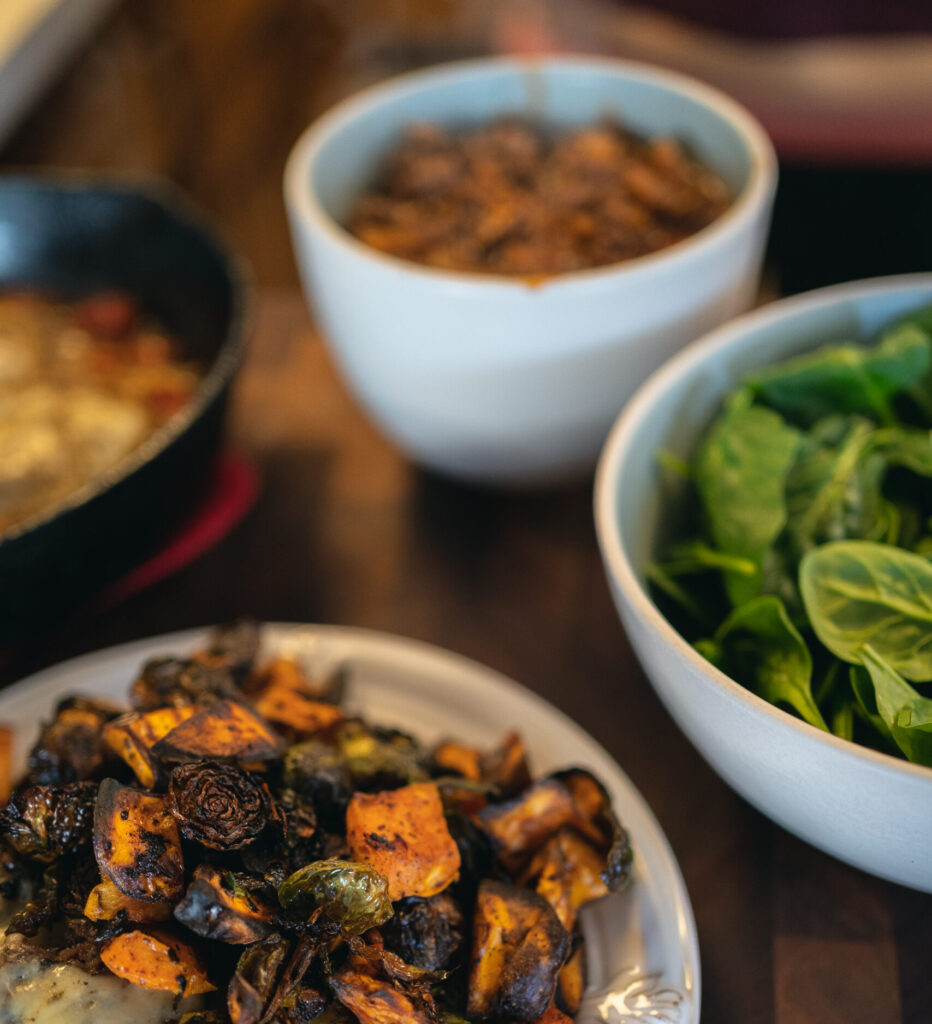Counting Macros for Dummies
 First, you’re definitely not dummies if you find counting macros confusing. One wrong turn can leave you frustrated, at a plateau, and ready to throw in the towel on better nutrition.
First, you’re definitely not dummies if you find counting macros confusing. One wrong turn can leave you frustrated, at a plateau, and ready to throw in the towel on better nutrition.
So let’s take it step by step so you have a clear understanding of how counting macros works. We’ll start at the beginning so you feel confident to take action right away. Or come back to it whenever you get stuck.
What's a Macro? Why Count Them?
Losing and gaining weight – whether fat or muscle – happens through energy in and out. Burn more energy than you consume in the form of calories, and you’ll lose weight.
However, not all calories are created equal. Protein builds muscle, which helps you burn more calories at rest. And lean muscle defines and shapes your body too.
Carbohydrates give you energy and help you recover from those muscle-building workouts faster. And fats help your hormones do their jobs for your overall health.
(There’s much more to all of this, of course, but let’s stay simple for now.)
Counting macros is a process of tracking your intake of protein, fats, and carbs throughout the day, as well as your overall calories.
How are these numbers determined?
The first thing to know about counting calories – for “dummies” – is that your number is personalized to your body and goals. Working off a generic 2000 calorie per day goal, or off of someone else’s calorie goal, won’t work. That’s because your weight, height, age, and activity level all factor in.
So before you count macros, find the target number of calories for your needs. You can do this using our free macro calculator.
Counting Macros - Tips For Beginners
- Don’t overestimate your activity level – this is a common mistake
- Select Moderate for Protein and Carbs – you can always adjust later
- An accurate body fat scan is best, but if you don’t have one, start with the numbers given, try them for a few weeks, and adjust from there
How to calculate your macros:
A macro calculator will estimate your daily calorie burn at rest – this is your BMR, or Basal Metabolic Rate. Next it will give target calories based on your activity and goals.

It will also give you target protein, carb, and fat grams per day.
- 1 gram of protein = 4 calories
- 1 gram of carbohydrate = 4 calories
- 1 gram of fat = 9 calories
If you multiply your protein, carbs, and fat grams by these numbers, you’ll find it matches your target calories for the day.
Example:
2000 calories per day
650 calories in protein (163 grams)
675 calories in carbs (169 grams)
675 calories in fat (75 grams)
Counting Macros For Dummies - In Meals
Now we need to take those numbers and put them on a plate.
This is easiest with an app such as Cronometer or MyFitnessPal. (Both are free.)
Start with Protein
Because protein is so important, make it the center of every meal. Divide your protein grams for the day by the number of meals you’d like to eat (hint: 3 or 4 is ideal).
Example: 120 protein grams per day with 4 meals of 30 grams of protein each
Choose your protein for each meal and enter it into your app.
You might be surprised, for example, that 1 egg is only 6 grams of protein. That means you’ll need 5 eggs for breakfast if that’s your only protein source. Learning these things is part of the process. As you go, you’ll learn that you can add egg whites to your omelet, for example, or have a turkey patty on the side.
Fill in carbs and fats:
Now you can round out your meals with desired carbs and fats. Some protein is quite lean and you’ll need to add more fat elsewhere. Healthy sources like nuts, avocados, butter, or cheese will help. Or if your protein source is fatty, you may just need some carbs in your meal. I recommend using vegetables, fruits, and starches like potatoes, rice, or oats for these.
Adjust where needed:
Finally, you may need to adjust your macros here and there to reach the desired daily amounts for each category. Weigh and measure your food to be as precise as you can.
Pro Tips:
- Keeping meals simple, rather than trying to incorporate lots of ingredients for a dish, will make the process much easier. Cooking your own food also really helps!
- App databases of food aren’t always accurate. So if that potato rings up at 3,000 calories, it’s definitely worth a second look.
- Weigh meat raw before you cook it. The water that releases during cooking affects the final amount.
What If It Doesn't Work?
If you count your macros consistently for a few weeks and don’t see any change, here’s what to do:
- Be sure you accurately weigh and measure everything you eat or drink
- Use more than one body assessment – pictures tell a different story than the scale. Or you can use a tape measure, or a body scanner if you have access to one.
- Adjust your calories by about 10% – fewer if you are trying to lose weight, more if you are trying to gain. Your macros will change as a result.
- Consider changes to your activity level as well – you can always start over on the macro calculator when needed.
DO I have To Count Macros?
Nope! If all this sounds like a lot of work, it is. It can be highly educational and rewarding to learn exactly what goes into your food. But there are much simpler ways to get started. Or just dial back your routine when life gets too busy to enter food into an app every day.
nutrition for dummies: made easy
When you get more mindful about your eating, it helps to layer on habits one by one if you’re easily overwhelmed. Start at Tier One and if you really want to, you can count macros in Tiers 5 and 6.
The goal isn’t to reach Tier 6 for everyone. The goal is to find the lowest tiered approach that helps you achieve and maintain the body, health, and performance you desire. For some of you that might simply be starting and sustaining quality food choices indefinitely. For others, it might be prioritizing high protein foods, or weighing and measuring every meal.
Here they are, along with practical ways to implement each one.

Tier 1: Quality
Also known as “clean up the junk.” Get rid of packaged processed foods to remove unnecessary calories and get more nutrient-dense foods on your plate.
Practical Approach: 5 Ingredient Meals
If a food has a nutrition label with an ingredient list then don’t use it on your plate. Pick an ingredient from each category, or just a couple categories to make a meal. It is OK to double up in one category, just keep it to 5 simple ingredients on the plate.
- Protein – fish, turkey, chicken, steak, tofu
- Veggie – broccoli, lettuce, carrots
- Fruit – apple, melon, banana
- Starch – rice, potato, oatmeal
- Fat – almonds, butter, olive oil, etc
Tier 2: Prioritize Protein

Master this macro at every single meal. Learning that protein is the most important macronutrient on your plate is a key step early on. Once you’ve removed processed foods, the next step is to put protein at the center of every meal or snack.
Practical Approach: Construct every single meal you eat around a central ingredient that is protein-rich. This is going to help curb hunger throughout your day, build lean tissue (aka muscle), and allow you to perform better in your training.
A little supplementation with protein powder is fine here as long as you don’t go overboard. This step also means staying stocked with pantry protein. Or knowing how to problem solve protein on the road. Check the Practical Protein Guide to help you here (or you can find it free inside Persist).
Tier 3: Consistency
Learn how to structure a day of eating, and repeat the same schedule daily. You will have more predictable energy. You will learn what amounts of food satiate you and what amounts don’t. And you will start to have much better control of your food cravings and impulses.
Practical Approach: Choose how many meals you want to have a day. Set a schedule that you can stick to with the lifestyle that you tend to keep. Then set alarms to ensure you don’t miss meal time within a 30min window each day. Over time this will become routine and the alarms won’t be necessary.

Tier 4: Hand Portions
The next step is to start to understand how much of each macronutrient you need to feel, look, and perform your best. A great resource to start off with in order to learn how much you need is the free FBB MACRO CALCULATOR. Head over to this resource and input your information, select maintenance as your goal, and then choose moderate or high protein and moderate carbs. This will give you a great starting point for your macronutrient needs.
Practical Approach: Now you need a way to start understanding much of each type of food you need in order to hit these recommendations. Using a hand measurement is a simple first step that doesn’t require a scale or complex math. Head to this HAND PORTION GUIDE and you can translate your number into hand portions.
Tier 5: Weigh and Measure
Get detailed about your Protein, Carbs, and Fat. Hand portions are quite accurate and work for a lot of people. However, weighing and measuring your macronutrients will yield greater accuracy. This will build off the previous tier by taking the MACRO suggestions from the calculator. Now you’ll weigh your food and input numbers for each meal.
Practical Approach: Download a food tracking application for your computer or phone, such as Cronometer or MyFitnessPal, and start logging your food and drinks. A few pro tips:
- 5 ingredient meals make tracking much easier
- Be consistent in how you weigh – I weight meats raw because water loss from cooking is unpredictable
- Weighing is more accurate than scooping into measuring cups
- Every bite counts – which can also help control for mindless snacking
This process gets easier over time and will be less cumbersome once you get the hang of it. With that said, it will always require more energy than a hand measurement method or one of the previous tiers. And it can be less sustainable to continue over a long period of time. If that happens to you, move back down the tiers to something that feels repeatable.
Tier 6: Refine
Once you’ve learned how to repeatably hit your MACRO numbers daily, you can go back to the calculator. Further refinement happens with different goals and macronutrient settings. This stage should only come after you’ve made Tier 4 or Tier 5 a repeatable and sustainable habit. Until you know that you are hitting your macros and calories consistently, there is no reason to start this level of refinement.
Practical Approach: Consider what your body has to say. It can be tempting to try super low carb and high fat, for example, because that seems trendy. But are you really ready to start your day with a big glob of butter? By all means explore whether higher fats or higher carbs feel best for you if you wish, because we are all different here. Just remember what it will look like on your plate, and whether that seems appetizing and repeatable for you.

The Big Idea
Start simple and only get more complex if you’ve mastered something and still want more results. You can ascend this system and then after a period of time go back to a lower tier that requires less energy and effort. You’re totally in control of your approach.
Very few people accidentally, without any intention at all, arrive at bodies that look and feel great. Some people thrive at very low levels of commitment. Those are often the people you say to yourself, “how the heck does _______ look so good and they never are on a diet.”
Well that person probably follows the no processed food rule 90% of the time without having to think about it. They also move enough in their day to offset the calories they eat. So the result is they make “dieting” seem effortless and just part of their life.
This is the goal. Find the level of commitment that gets you the results you want without consuming your entire life. It takes work up front, but in the long haul, can be a healthy balanced lifestyle that appears to others like it is easy.
More Resources

Look Good. Move Well.
Workouts for sculpted arms and a six pack are different than those for speed and power. Get my blend of both and a sample nutrition plan. Plus a Big Bicep Bonus for my favorite arm finishers!
